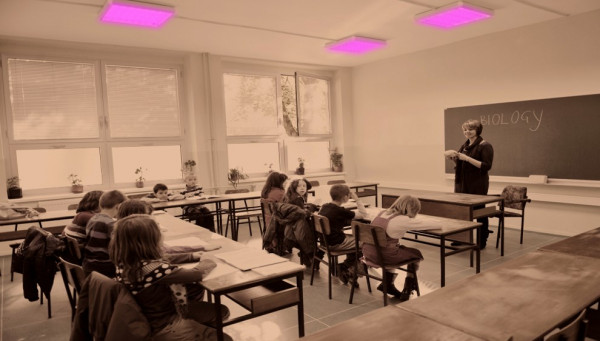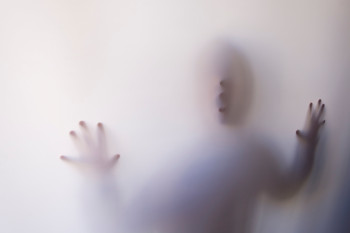© Pint of Science, 2024. All rights reserved.
What if I told you that a part of the UV light spectrum could be used to kill COVID-19? What if I also told you that these wavelengths are so far thought to be completely safe to humans? What would you say?
“Use it!” was my answer to Dr Kenny Wood, astrophysicist at the University of St Andrews, in a tutorial last year. The UK’s vaccination programme is now well under way, but virologists are not alone in the pandemic fight. More and more research is emerging from the world of medical physics on the use of far-UVC light to destroy the SARS-CoV-2 virus responsible for COVID-19. This includes work from teams here in St Andrews and at Ninewells Hospital in Dundee, that has caught the attention of both the UK and Scottish governments.
What is UVC light?
As you might know from your suncream bottle, on Earth we receive UVA and UVB light from the sun that may damage our skin and eyes, which can lead to skin cancer or cataracts. However, the sun also emits a third type of UV radiation: UVC. These wavelengths, at the shorter end of the spectrum (between 100-280 nm), are absorbed by ozone in the atmosphere before they can reach us on the ground.
Why is this important? Well, viruses and bacteria do not cope very well under the UVC spotlight. In fact, UV has been known for a long time to inactivate not only the SARS-CoV-2 virus, but thousands of different viruses, and even the bacteria behind drug resistant ‘Superbugs’! The idea originated following the universal acceptance of germs in the 19th century, and their role in causing disease. To face this new enemy, scientists began experimenting on the properties of bacteria - including the effects of UV...
In 1877, two British academics decided to put test tubes of salt solution in direct sun. Under normal conditions, the solution would have grown various microbes, but beneath the UV from the sun’s rays, it remained completely germ free. A surge of research that followed showed UVC to have the most effective bug busting ability of all, and this has been exploited ever since; from slowing the spread of infection during the 1957 influenza pandemic, to cleaning the New York subway, and even in Russian prisons.
New variants? No problem for UVC. Rather than target one specific part of the virus in the way a vaccine or drug does, the UVC light hits the virus like a sledgehammer, causing unpredictable damage to the genome. In other words, COVID doesn’t know what’s coming, and couldn’t possibly evolve to escape it!

A classroom under UVC light
Unlike UVA and UVB, there is hardly any evidence to suggest that UVC light can cause skin cancer. That said, exposure to some wavelengths can result in significant skin and eye damage. This means use of conventional germicidal lamps, at a wavelength of 254 nm, is limited by the necessary safety precautions, and often abandoned for other infection control methods. However, in a UV lightbulb moment, scientists discovered that some wavelengths of UVC may not be as dangerous as first anticipated…
Recent research suggests that ‘far-UVC’ at wavelengths below 230 nm poses no risk of skin or eye damage whatsoever. As it turns out, our bodies actually have a natural armour that these wavelengths cannot penetrate. Both the outermost layer of our skin, composed of dead skin cells, and the tear layer of our eyes, contain proteins that readily absorb all far-UVC, halting the light in its tracks.
This discovery has led to the production of new far-UVC technology that, at 222 nm, can shine down on an entire room of people alongside normal lighting at no risk, whilst continually disinfecting the air we breathe and the surfaces we touch.
As this is a relatively new concept, research by Dr Wood and others is needed to understand how far-UVC can be used to its full potential. For example, a study is ongoing to understand how UVC might be able to reduce the amount of SARS-CoV-2 virus in a classroom setting, using computer simulations co-created by local St Andrews company, Fluid Gravity Engineering.
The results show that, with an isotropic illumination of the entire room by eighteen 222 nm lamps at the current regulatory limits (known as TLVs), the viral concentration would reduce to ~ 0.1% in just over 25 minutes. If the wattages were increased 100-fold, however, the virus could be inactivated in less than a minute! A hundred times the current safety levels may sound like a lot, but ongoing safety studies suggest that this could definitely be a feasible reality.
Far-UVC light has huge potential. It could provide a tool, not only for the current pandemic, but for the prevention of other infectious viruses in the future. And research into its application is building too - in fact, after a recent UK government innovation workshop, far-UVC was identified for acceleration funding so further studies into the long-term safety and efficacy can be planned and prepared worldwide. Watch this space – UVC could very well be that light at the end of the tunnel.
About the Author
Rachel Black is an undergraduate Astrophysics student, studying at the University of St Andrews. She has a great enthusiasm for scientific communication, and is currently a content editor for Panda magazine, the University’s official Physics and Astronomy magazine. You can find her on Twitter @rach_black1.
Image taken from the Centre for Radiological Research at Colombia University.
Virus inactivation plots and images provided by Dr Kenny Wood and Dr Camilo Penaloza Cabrera from the University of St Andrews, and Dr Andrew Wood from Fluid Gravity Engineering.




